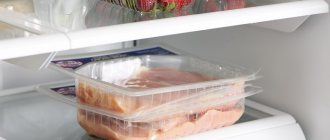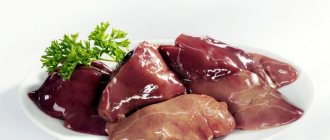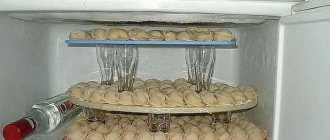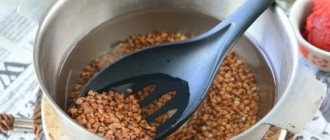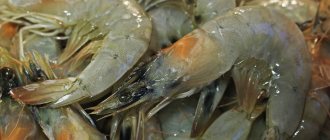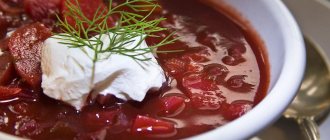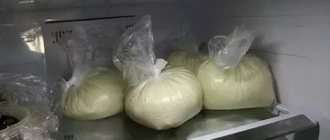Properly selected temperature in the refrigerator for storing food affects its taste and shelf life. If it is too low, food may freeze and lose taste and appearance. High – leads to increased proliferation of bacteria, making food dangerous to eat.
Having bought a refrigerator, we don’t even always read the instructions - we just turn it on. If there is no display, then we put the regulator in the middle position and assume that the normal temperature has already been set in it.
Temperature norm and its meaning
A refrigerator is a necessary attribute in every family. It helps keep foods fresh, safe and healthy, and cool drinks. Not everyone thinks about the question of what temperature should be in the refrigerator and what this affects.
A correctly adjusted operating mode is necessary for:
- food safety;
- preventing the occurrence of unpleasant odors;
- reducing electricity consumption;
- increasing the time interval between defrosting the freezer;
- increasing the service life of equipment.
There is no clear answer to the question of what the optimal temperature in the refrigerator and freezer should be. This indicator varies significantly in different areas of the refrigerator compartment. It is necessary to take into account the range of products that are stored there; usually it ranges from – 2 to + 5°C.
If we are talking about a freezer, before choosing a mode, you need to determine whether a lot of food is stored in it, how often you open it, and whether you use the “quick freezing” function.
Does the freezer operate at subzero temperatures?
When starting the thermal relay in sub-zero ambient temperature conditions, it is possible to turn on the system, however, what will happen next:
- The thickening of the system lubrication leads to increased frictional resistance, in this process the overload protection begins to operate;
- Freon boils partially, the compressor begins to gradually compress the gas and liquid mixtures, and the liquid itself does not have the strength to resist compression;
- The No Frost system does not work in cold weather due to the fact that the evaporator is covered with ice;
No Frost system does not work in cold weather - The sealing parts lose their elastic properties and depressurization occurs.
Important! Freezers do not work in sub-zero climates; they quickly fail, and the entire system is destroyed.
Cold zones in the refrigerator
The indicator accurately displayed on the display is the average temperature in the refrigerator, i.e. the temperature differs in different zones. It must be remembered that the lowest temperature is on the shelf closest to the freezer and at the back wall.
If the freezer is located at the bottom, then inside the refrigerator (set to +4°C on the sensor) the zones will be distributed approximately as follows:
- bottom shelf: from 0 to + 3°C;
- next: from +3 to + 4°C;
- average: + 4°C;
- upper: from + 4 to + 6 °C.
These are average indicators. The more often you open and close the door, the faster the space inside the chamber heats up.
Why is it so important to monitor your temperature?
First of all, how long the food will remain fresh and tasty depends on what mode is set in your refrigerator. You can understand that the temperature is not normal by the following signs:
- Food spoils quickly.
- Traces of rot and mold appear on vegetables and fruits.
- There is an unpleasant odor inside the camera that quickly returns despite your efforts.
- The compressor does not stop working (this may be evidence of a breakdown, but incorrect operation is also possible).
- Frost forms quickly and you have to defrost the device frequently.
These unpleasant symptoms indicate the presence of certain problems in the operation of the unit. The first step is to make sure the settings are correct.
Optimal temperature in zones
The coolness in the refrigerator is distributed depending on the distance to the freezer. This feature is very important; it allows you to choose the right place for products that require different storage conditions. Manufacturers recommend maintaining the standard refrigerator temperature at +4 °C. These indicators allow you to create the necessary conditions inside and on the shelves of the unit.
The refrigerator compartment can be divided into zones:
- “Fresh zone” – the compartment has from +5 to +8 °C and a high level of humidity.
- The shelves on the door are the warmest place. Depending on the frequency of opening, food is stored here at +5 – +10 °C.
- On the middle shelves it is a little colder and is +3 – +5 °C.
- The shelf at the top or bottom of the compartment closest to the freezer is the coldest place in the refrigerator. Depending on the location of the freezer, this is the top or bottom shelf. Here it will be at +2 – + 3 °C.
The less often you open the door, the more evenly the cold is distributed throughout the internal volume of the unit. The selected value of +4°C is the optimal temperature in the refrigerator under normal conditions, ensuring the safety of food products. In extreme heat, the indicator must be reduced.
Temperature in the refrigerator compartments
The instructions for the unit indicate what temperature should be in the freezer - usually now this figure is -18°C. But if it is possible to regulate it, then you need to consider the following:
- If you need to keep frozen food for no more than one month, -6°C is sufficient. In this case, the products are stored frozen. Vegetables, fruits, legumes and fish require lower storage temperatures.
- At –12°C the same foods can be stored for up to 3 months without being thawed.
- At a freezer temperature of –18°C, storage time increases to a year.
Maintaining constant conditions is especially important during long-term storage; even a short-term increase in temperature sharply reduces its shelf life. Modern models of freezers provide a freezing mode of –24 °C and storage at – 18 °C. In modern models, freezing occurs at – 24 °C, then –18 °C is automatically set, this is the optimal temperature for storing food in the freezer.
Storing fruits and berries
Northern fruits and berries are stored well at low temperatures (from -1 to +2C). But exotic fruits require heat (+10C and above).
More precise numbers are shown in the table (see Fig. 14):
It is advisable to keep dried fruits at a temperature of 0C. Jam requires high humidity and temperature from +10 to +15C. Frozen fruits are stored at -18C.
Average refrigerator temperature
Any household refrigerator has a range of operating temperatures, usually it varies from 0°C to +8°C.
The average temperature in the refrigerator depends on several factors:
- frequency of opening the door - each time warm air enters the chamber;
- degree of fullness of the chamber - if there is very little food, a sharp temperature change occurs when the door is opened;
- environmental factors - operating conditions in summer and winter are significantly different. The NoFrost system maintains the temperature regime of the refrigerator and ensures the smallest temperature difference.
The temperature in the freezer depends on the model, it is determined by the number of stars or snowflakes on the panel:
- (1 star) – from –6°C to –12°C;
- ** (2) – from –12°C to –18°C;
- *** (3) – from –18°C to –24°C;
- **** (4 stars) – from –24°C and below in some models.
The recommended temperature in the refrigerator should be between +2 and +4 degrees Celsius, and in the freezer –18.
Professional flower transportation
In a state of suspended animation, flowers are able to travel long distances. This state can be figuratively called “neither alive nor dead,” when metabolic processes in the flower practically stop. In this form, roses, orchids, chrysanthemums, and gerberas travel to Russia from Latin America, Africa and Europe.
The process of professional “freezing” of flowers is called priming. This is the introduction of plants into a state of suspended animation. The flowers are placed in special refrigerators before they are loaded onto the plane. The temperature at which roses can travel is approximately 4 degrees Celsius. If it is even half a degree colder, the flowers will freeze; if it is warmer, they will begin to wither.
After cutting, metabolic processes in flowers do not stop, which lead to premature withering of plants. To slow them down, you need to choose the right storage temperature. The rate of biological aging slows down when flowers cool. It allows you to extend the “life” of a bouquet in a vase, keeping it fresh and beautiful for a long time. The faster the plants are cooled after cutting, the greater the chance they will last up to several weeks.
refrigerator door
The refrigerator door, as already mentioned, is the zone with the highest and constantly changing temperature. When the door is opened, warm air enters the food; after closing, the air begins to cool. It is important to consider the temperature on the refrigerator door and choose products that will maintain freshness in such conditions.
In modern models, manufacturers offer door shelves designed for short-term storage:
- drinks;
- vegetable oils;
- hot sauces;
- vinegar;
- canned food;
- cheese;
- butter.
As a general rule, you can store products in this area that are intended for quick use. Do not overload the door; distortion can lead to a leak.
How to properly store food in the refrigerator
In order for food to remain fresh longer, it is necessary to place it correctly and accurately set the thermal conditions.
You cannot arrange the packages in any order; it is important to follow the following rules:
- The coldest shelf (top or bottom depending on the location of the freezer) is intended for perishable food - meat and fish products, dairy products, desserts, open canned food.
- On the middle shelves you can place pots of soup or borscht, side dishes, salads, and boiled eggs.
- You can store bottles of drinks, vegetable oils, vinegar, and containers with fresh eggs on the door. This place guarantees the freshness of confectionery products that do not require temperature - sweets, chocolate.
- The retractable containers located at the bottom of the chamber are called the “freshness zone”. The temperature is kept at 0°C and the humidity level is high. Vegetables, fruits and herbs remain fresh for several days.
- Freezer compartment is a compartment for storing products that need to be kept fresh in a frozen state (meat, fish, semi-finished products, berries, vegetables, fruits, ice cream).
It is important to place containers with food so that they do not touch each other - this will ensure good cooling.
Recommended temperatures for food
The table shows the optimal temperature and recommended storage periods for different food groups.
| type of product | temperature | ||
| minimum | maximum | permissible storage period, days | |
| Fresh chilled meat | –1 | –3 | 1,5 |
| Fresh eggs | +1 | +2 | 20 |
| Boiled eggs | +1 | +2 | 5–7 |
| Fresh fish and seafood | +2 | +2 | 2 |
| Milk | 0 | +1 | Depending on the type of packaging |
| Fermented milk products | +1 | +4 | 7 |
| Cheese | +3 | +4 | 20 |
| Ready-made meat dishes | +4 | +8 | 1–2 |
| Desserts with cream | +1 | +3 | 3 |
| Butter | –18 | –24 | 90 |
| Opened canned meat or fish | +3 | +5 | 2 |
| Boiled sausage, sausages | +1 | +2 | 2 |
| Side dishes | +2 | +3 | 2 |
Storing chilled meat
Pork, beef and lamb are best stored at -1C. At -2C the meat will become frozen. The shelf life of such a product will increase, of course, but the taste will also change.
At a temperature of -1C, chilled meat of large animals can last quite a long time - up to 16 days. But only on the condition that the products were not crushed. GOST standards recommend keeping such meat in the form of carcasses, half-carcasses or quarters. Approximate shelf life is given in the table (Fig. 1):
Shredded meat and minced meat do not last long, from 12 to 48 hours. By-products are also stored for about the same amount (see Fig. 2):
Chilled poultry and rabbit meat is more delicate and should be kept at 0C. Place the carcasses whole in refrigeration chambers. Then their shelf life will increase to 5 days. Portioned pieces are stored for no more than 2 days (see Fig. 3):
Chilled meat from young animals (piglets, calves, chickens) will spoil 1.5–2 times faster than meat from adults.
You can increase the shelf life of meat by vacuum packing it or treating it with gas (ozone, nitrogen, carbon dioxide). However, the second method is rarely used.
In ordinary household refrigerators, the temperature is most often maintained from +2C (on the top shelf) to +6C (on the bottom). The exact numbers can be found in the device passport. Place meat products on the top shelves.
Temperature adjustment for different refrigerator models
Manufacturers of refrigeration equipment solve the issue of choosing a temperature control method in different ways.
Refrigerator temperature control knob
Belorussky produces single-chamber and double-chamber units. To set the temperature, there is a regulator that allows you to select one of 7 modes. The manufacturer recommends setting the regulator at 3. If this is not enough, you can move the mark to 5. When the required degree of cooling is achieved, it is advisable to return the knob to 3 - this is enough to maintain the required level.
Atlant models with two compressors (separately for the refrigeration and freezer compartments) have 2 regulators. The temperature set at 3 to 5 guarantees normal operation. Modern models are equipped with a digital panel to control the temperature in the freezer and refrigerator compartments. As a rule, it is enough to set the necessary parameters. Precise information on how to adjust the temperature in the Atlant refrigerator is available in the instructions.
Setting the temperature in a Samsung refrigerator can be done in two ways - mechanical or electronic, depending on the model. In the first case, installation is carried out using the thermostat knob, and in the second, using the service menu control buttons. The specified parameters will be displayed on the display. In a two-chamber refrigerator, you need to set the temperature in each chamber; they work independently of each other.
The temperature in the Indesit refrigerator is adjusted using a mechanical regulator with 5 positions. Twin-motor models have a panel with two handles. Settings are made separately for the freezer and refrigerator. There is no digital scale; it is replaced by a thickening semicircular line with marks. The thicker the line, the lower the temperature.
To measure how many degrees in a refrigerator that does not have an electronic display, just put a glass of water for several hours and measure the temperature of the water. If the range is from +2 to +4 °C, then the unit is operating normally. An easier way is to simply put the thermometer in the refrigerator and check the readings after 15–20 minutes.
You can quickly measure the temperature in the refrigerator by leaving the thermometer in it for a few minutes.
If the values differ up or down, then adjust and take measurements again.
Climatic class of equipment
Modern refrigerators are manufactured according to the zonal principle. All countries or their individual territories are classified according to climate characteristics.
For example, for a group of Scandinavian countries, models with a slightly lower thermal insulation rating are relevant. The compressor is also somewhat deformed. And for countries in the hot tropics, more powerful and wear-resistant devices are needed.
It is logical that if the average annual temperature in the room is several degrees higher, the refrigerator will work more intensively. Therefore, a device model for hot countries costs more than a similar one for the Scandinavians.
Follow the instructions for using the refrigerator. If they are violated, the actual temperature reading will not be equal to the nominal temperature for the selected operating mode
Often the compressor runs almost continuously in tropical countries. However, even under such conditions it is difficult for him to provide the temperature corresponding to the selected mode. Which is not surprising when warm air with a conventional temperature of 40 ºС heats the device from all sides.
Refrigerators for tropical countries are slightly more expensive than their counterparts for cold countries. It is difficult to find them on our market, but according to most technical characteristics they look more convincing.
